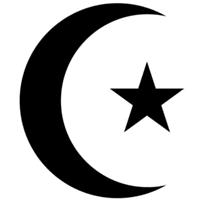As surprising as it may be to the uninitiated, Islam discourages the use of “holy symbols” in the same manner that Christians use the cross to symbolize their faith, or how Judaism is represented by the menorah or the Star of David. Early Muslim authorities prohibited the use of any geometric shapes to symbolize Islam. This is the reason why Islamic coins bore no visual symbols but are instead covered in Arabic writing.
Color
Despite the prohibition, symbolism still found its way into many things Islamic. Symbols are used to convey an association with Islamic traditions and beliefs. For example, it is said in the Quran (Surah 18:31) that “those who inhabit paradise will wear fine silk garments of green”. This particular verse has thus been interpreted over the centuries, and the colour green has now been associated with Islam (never officially) for a long time. Qurans are actually covered with green bindings, mosques are decorated with green as the predominant color, Sufi saints have their graves covered with green silk and the color green figures prominently in the flags of many Muslim countries.
The colour white is universally known to symbolize peace and purity. Many Muslims wear white for Friday prayers. Black is a symbol of mourning in many cultures around the world, but in Islam, it symbolizes modesty. Red, although not particularly significant for Muslims, is common on the flags of Muslim countries.
These four colours, green, black, white and red, are the dominant colours found in the flags of most Arab states.
The Star and Crescent
The star and crescent are actually the best-known symbols of Islam. It adorns the top of Muslim mosques and is featured quite prominently as the major element in many Islamic flags, as in the national flags of Turkey and Pakistan. Many historians point out that this symbol actually originated from the Ottoman Empire and is not of Islamic origins at all. It is considered a case of cultural diffusion. As Islam spread to the Ottoman Turks, who used this symbol on their flag, it also began to be associated with Islam. This controversy remains today. Those who advocate using the crescent as the symbol of Islam cite certain verses in the Quran to support their stand, and many Islamic nations and organizations today incorporate the crescent into their logos or flags.

Other Islamic Symbols
Particular words written in Arabic script are considered as visual representations of Islam, such as the word “Allah” or the Muslim profession of faith, the “Shahada”. The sword is also a Shi’ite symbol associated with Imam Ali, who is said to have fought for Islam with this sword. One particular place that also symbolizes “Janna” (paradise) for Muslims is the Gardens of the Mughal Empire in India. Although the Quran does not identify any particular colour or symbol to represent Islam, these symbols result from the understanding and interpretations of Muslim thinkers, politicians, and artists over the centuries.
Rub el Hizb
Rub el Hizb is an important figure that has come to be associated with the Islam religion. It is a symbol made of two overlapping squares where one square is turned at 90 degrees and thus creates an 8-pointed star. There is also a circle in the center of both squares. In Arabic, ‘Rub’ stands for quarter or one-fourth, while’ Hizb’ means a party or group. It is used in Arabic calligraphy to mark a chapter’s end and appears in the Quran at the end of passages. The Quran is divided into sixty ‘Hizb’, which are 60 equal-length portions, and these are further divided into ‘rub’ or quarters.
The Rub el Hizb symbol can be seen on several flags, emblems and coats of arms, such as those of Morocco, Turkmenistan, and Uzbekistan.

